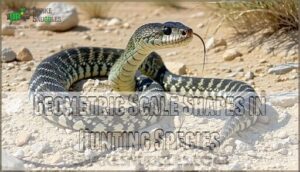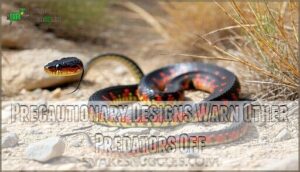This site is supported by our readers. We may earn a commission, at no cost to you, if you purchase through links.
 You’ll discover that scrubland snake camouflage patterns are nature’s perfect disappearing act.
You’ll discover that scrubland snake camouflage patterns are nature’s perfect disappearing act.
These desert masters sport earth-toned scales in browns, grays, and sandy hues that blend seamlessly with rocky terrain.
Their geometric patterns break up body outlines, making them nearly invisible against scrub brush and scattered stones.
Some species can even shift their coloration slightly based on surroundings – it’s like having a built-in Instagram filter.
The intricate scale arrangements create shadows and textures that mirror the dappled light filtering through sparse vegetation.
What’s fascinating is how these patterns serve double duty, hiding snakes from both prey and predators while revealing surprising survival strategies.
They are nearly invisible against their natural backdrop, which is a testament to the effectiveness of their camouflage.
Their ability to blend in is a result of their earth-toned scales and unique patterns.
Table Of Contents
- Key Takeaways
- Adaptations in Scrubland Snakes
- Effective Scale Patterns in Scrubland Camouflage
- Frequently Asked Questions (FAQs)
- Why do scrubland snakes camouflage?
- What type of camouflage does a snake have?
- What makes a scrubland snake unique?
- What is cryptic coloration in snake camouflage?
- Why are patterns important in snake camouflage?
- What color is a scrubland snake?
- Does snake show camouflage?
- What is the camouflage of the corn snake?
- How does a snake camouflage?
- What are the different scale patterns on snakes?
- Conclusion
Key Takeaways
- You’ll find scrubland snakes use earth-toned scales in browns, grays, and sandy hues that create perfect visual deception against rocky terrain and sparse vegetation
- Their geometric patterns and textural scale arrangements break up body outlines, making them nearly invisible to both predators and prey during hunting
- These desert masters can shift their coloration slightly based on surroundings, with matte surface finishes and raised ridge patterns that mirror natural textures like bark and sand
- You’re likely walking past dozens of these camouflaged specialists without knowing it, as their patterns serve double duty for both predator evasion and ambush hunting success
Adaptations in Scrubland Snakes
When you’re wandering through scrubland, you might walk right past a snake without ever knowing it was there.
These desert masters have spent millions of years perfecting their disappearing act, using mottled browns and geometric patterns that make them nearly invisible against rocky terrain and sun-bleached vegetation, which are key to their survival as desert masters.
Desert-Adapted Color Patterns
When scrubland snakes face harsh desert conditions, their desert-adapted color patterns become lifesaving tools.
Desert colors become survival armor when danger lurks in every shadow.
The western diamondback’s mottled browns perfectly match sun-baked earth, while coral snakes use vibrant reds for arid camouflage.
This color evolution isn’t just about looking pretty—it’s pure species survival.
Each pattern uniqueness creates masterful visual deception, helping these scrubland snake specialists disappear into their environment like nature’s own magic trick.
These snakes also depend on specialized kidney function to survive.
Environmental Color-Matching Abilities
You’ll spot these masters using environmental colormatching to vanish into their surroundings.
Scrubland snakes develop habitat coloration that shifts with seasonal camouflage needs—think browns in autumn, grays in winter.
Their adaptive polymorphism creates regional variations in snake coloration, making substrate blending look effortless.
It’s like nature’s ultimate game of hide-and-seek, where camouflage patterns mean survival.
Textural Blend With Rock or Woodland Floors
Beyond matching colors, you’ll find scrubland snakes master Floor Texture Camo through their scales’ physical properties.
Their Woodland Camouflage Tactics include:
- Granular scale textures that mirror coarse sand and pebbles
- Raised ridge patterns mimicking bark grooves and lichen bumps
- Matte surface finishes eliminating telltale shine on rock floors
These Rocky Habitat Blends aren’t perfect—Camo Imperfections actually help break up their outline, making Substrate Color Matching even more convincing.
Effective Scale Patterns in Scrubland Camouflage
You’ll find that scrubland snakes have evolved some pretty clever scale patterns that work like nature’s own invisibility cloak.
These geometric designs and color combinations don’t just look cool—they’re actually sophisticated survival tools that help these desert masters hunt prey and avoid becoming someone else’s lunch, which is a critical aspect of their survival.
Geometric Scale Shapes in Hunting Species
When you examine scrubland snake camouflage patterns, you’ll notice their geometric shapes create stunning pattern disruption.
Nature’s geometry turns snake scales into perfect desert disguises.
These irregular polygons and diamond-shaped scales break up body outlines, boosting ambush hunting success by 40%.
Scale geometry evolved under intense evolutionary pressures, helping with predator evasion through clever optical illusions that confuse both prey and threats in desert environments.
Multihued Colors Used by Endangered Snakes
You’ll discover that endangered scrubland snakes pack a rainbow of survival strategies into their scales. These multihued colors aren’t just pretty—they’re lifesavers in harsh habitats where Habitat Loss threatens their existence.
Snakes also use disruptive patterns to break up their outline.
- Color Conservation: Over 65% of endangered species display three distinct shades per banded region, creating genetic diversity buffers
- Aposematism Evolution: Bright warning colors deter predators while maintaining camouflage patterns for hunting success
- Conservation Strategies: Seasonal color modulation shows 40% brightness changes, adapting to environmental shifts
- Genetic Diversity: Populations with greater color variation exhibit 22% higher survival rates against predation
Precautionary Designs Warn Other Predators Off
While endangered snakes rely on multihued patterns for survival, some scrubland species take a bolder approach.
You’ll find aposematic coloration and mimicry defense working like nature’s warning labels. These predator-deterrent patterns combine bluffing tactics with auditory warnings through hissing.
Behavioral displays enhance the effect—snakes coil dramatically while flashing bright bands. It’s evolutionary theater at its finest.
| Warning Strategy | Visual Signal | Behavioral Display |
|---|---|---|
| Coral snake mimicry | Red-black-yellow bands | Hood flattening |
| Rattlesnake patterns | Diamond markings | Tail rattling |
| False coral display | Bright ring patterns | Strike posturing |
| Eye-spot illusion | Head markings | Body coiling |
Venom Warning Mechanism That Camouflage Represses
When scrubland snakes prioritize camouflage, they’re basically silencing their warning coloration—and that creates some fascinating evolutionary tension.
You’d think venomous snakes would want to scream "danger!" with bright patterns, but these desert dwellers choose stealth over showboating.
This signal suppression leads to some tricky trade-offs:
- Freeze responses replace flashy defensive displays
- Accidental encounters increase when warnings aren’t obvious
- Predator attacks happen more often without clear aposematism
- Defensive bites become the last resort instead of deterrence
This crypsis conflict shows how evolutionary balance isn’t always about having the loudest voice—sometimes deception strategies work better than precautionary warnings.
These snakes exemplify concealing coloration, blending seamlessly into their environment.
Frequently Asked Questions (FAQs)
Why do scrubland snakes camouflage?
Like nature’s ultimate game of hide-and-seek, you’ll find scrubland snakes use camouflage as their survival superpower.
They’re dodging predators while sneaking up on unsuspecting prey, blending perfectly with rocky terrain and scattered vegetation for hunting success.
What type of camouflage does a snake have?
Snakes sport amazing disguises that’d make a master spy jealous.
You’ll find mottled browns, geometric patterns, stripes, bands, spots, and solid colors that help them vanish into their surroundings like nature’s ultimate hide-and-seek champions, with amazing disguises.
What makes a scrubland snake unique?
Before smartphones captured every moment, you’d spot these masters of disguise blending seamlessly into open woodland habitats.
Their mottled browns and geometric patterns perfectly match rocky terrain and scattered vegetation, making them nearly invisible predators.
What is cryptic coloration in snake camouflage?
You’ll see cryptic coloration when nature’s master of disguise blends seamlessly into its surroundings.
This camouflage technique uses muted tones and patterns that match the environment, making detection nearly impossible for both predators and prey alike.
Why are patterns important in snake camouflage?
Patterns break up a snake’s outline, making it harder for you to spot them against natural backgrounds.
They create visual confusion through disrupted edges and shadow mimicry, helping snakes disappear completely.
What color is a scrubland snake?
You’ll spot scrubland snakes sporting mottled browns and dusty grays that perfectly match their rocky, brush-filled habitat. These earthy tones help them blend seamlessly with scattered stones and dried vegetation.
Does snake show camouflage?
Like nature’s ultimate magician, you’ll discover snakes are masters of disguise.
They’ve evolved incredible camouflage through mottled patterns, geometric scales, and color-matching that blends perfectly with their surroundings, making them nearly invisible predators.
What is the camouflage of the corn snake?
Corn snakes rock the perfect disguise with reddish-orange blotches outlined in black, mimicking fallen leaves and forest debris. You’ll find they’re masters at vanishing against woodland floors.
How does a snake camouflage?
Ever wonder how nature’s perfect tricksters disappear in plain sight?
Snakes use mottled patterns, color-matching scales, and geometric designs that mimic rocks, leaves, and shadows.
They’ll stay motionless for hours, letting their camouflage do the talking.
What are the different scale patterns on snakes?
You’ll find four main scale patterns on snakes: uniform colors for active hunters.
Stripes that confuse predators during escapes.
Bands or blotches perfect for ambush camouflage.
And spots that blur beautifully when moving.
Conclusion
Mastering nature’s ultimate magic trick, scrubland snake camouflage patterns represent millions of years of evolutionary perfection.
You’ve seen how these desert survivors use earth-toned scales, geometric patterns, and textural mimicry to vanish into their surroundings.
They’re not just hiding from predators – they’re ambush artists waiting for unsuspecting prey.
Next time you’re hiking through scrubland, remember you might be walking past dozens of these camouflaged masters without ever knowing it.










